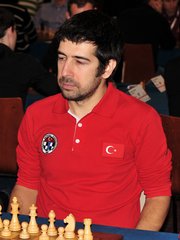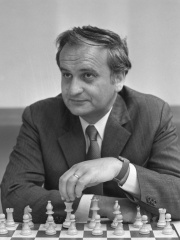
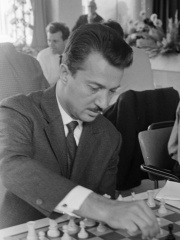
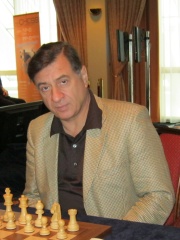
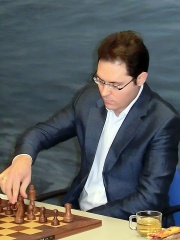
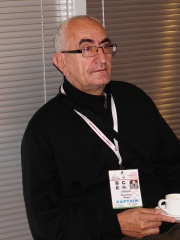
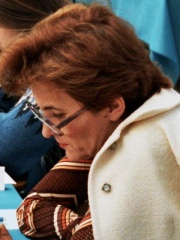
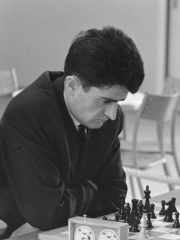
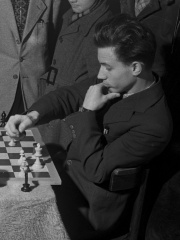
The Most Famous
CHESS PLAYERS from Serbia
This page contains a list of the greatest Serbian Chess Players. The pantheon dataset contains 461 Chess Players, 12 of which were born in Serbia. This makes Serbia the birth place of the 13th most number of Chess Players behind Georgia, and Armenia.
Top 10
The following people are considered by Pantheon to be the top 10 most legendary Serbian Chess Players of all time. This list of famous Serbian Chess Players is sorted by HPI (Historical Popularity Index), a metric that aggregates information on a biography's online popularity. Visit the rankings page to view the entire list of Serbian Chess Players.

1. Borislav Ivkov (1933 - 2022)
With an HPI of 64.86, Borislav Ivkov is the most famous Serbian Chess Player. His biography has been translated into 24 different languages on wikipedia.
Borislav Ivkov (12 November 1933 – 14 February 2022) was a Serbian chess Grandmaster, three-time Yugoslav Champion (1958, 1964, 1972), the first World Junior Champion (1951), and one of the most decorated players in the history of Chess Olympiad. He was a World championship candidate in 1965 and played in four more Interzonal tournaments in 1967, 1970, 1973 and 1979. He represented Yugoslavia 12 times in Olympiad competition, from 1956 to 1980, and six times in European Team Championships. Ivkov won numerous top-class events during his career; notable tournament triumphs include Mar del Plata 1955, Buenos Aires 1955, Beverwijk 1961, Zagreb 1965, Sarajevo 1967, Amsterdam-IBM 1974, and Moscow 1999. For more than 15 years from the mid-1950s, he was the second-ranking Yugoslav player, after Svetozar Gligorić. He wrote an autobiography, My 60 Years in Chess.

2. Svetozar Gligorić (1923 - 2012)
With an HPI of 62.15, Svetozar Gligorić is the 2nd most famous Serbian Chess Player. His biography has been translated into 33 different languages.
Svetozar Gligorić (Serbian Cyrillic: Светозар Глигорић; 2 February 1923 – 14 August 2012) was a Serbian chess grandmaster and musician. He won the championship of Yugoslavia a record 11 times, and is considered the best player ever from Serbia and Yugoslavia. In 1958, he received the Golden Badge award for the best athlete of Yugoslavia. During the 1950s and 1960s, Gligorić was one of the top players in the world reaching the Candidates Tournament three times (1953, 1959, 1968). In his career he won both team (1950) and individual board 1 (1958) gold medals at the Chess Olympiad thus becoming one of the few players in chess history to do so (along with Kashdan, Rubinstein, Botvinnik, Petrosian, Spassky, Karpov, Korchnoi, Kasparov, Ivanchuk, Aronian, Ding and Gukesh). He was also among the world's most popular players, owing to his globe-trotting tournament schedule and a particularly engaging personality, reflected in the title of his autobiography book, I Play Against Pieces (i.e., without hostility toward the opponent, and not differently against different players for psychological reasons; playing "the board and not the man").

3. Ljubomir Ljubojević (b. 1950)
With an HPI of 59.79, Ljubomir Ljubojević is the 3rd most famous Serbian Chess Player. His biography has been translated into 23 different languages.
Ljubomir Ljubojević (Serbian Cyrillic: Љубомир Љубојевић; born November 2, 1950) is a Serbian chess grandmaster. He won the Yugoslav Chess Championship in 1977 (tied) and 1982.

4. Peter Leko (b. 1979)
With an HPI of 57.94, Peter Leko is the 4th most famous Serbian Chess Player. His biography has been translated into 44 different languages.
Peter Leko (Hungarian: Lékó Péter; born September 8, 1979) is a Hungarian chess grandmaster and commentator. He became the world's youngest grandmaster in 1994. He narrowly missed winning the Classical World Chess Championship 2004: the match was drawn 7–7 and so Vladimir Kramnik retained the title. He also came fifth in the FIDE World Chess Championship 2005 and fourth in the World Chess Championship 2007. Leko has achieved victories in many major chess tournaments, including the annual tournaments at Dortmund, Linares, Wijk aan Zee and the Tal Memorial in Moscow. He won two team silver medals and an individual gold medal representing Hungary at eight Chess Olympiads as well as team bronze and silver and an individual silver medal at three European Team Championships. Leko has been ranked as high as fourth in the FIDE world rankings, which he first achieved in April 2003.
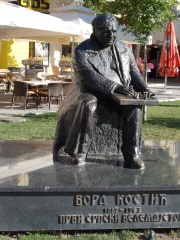
5. Boris Kostić (1887 - 1963)
With an HPI of 56.16, Boris Kostić is the 5th most famous Serbian Chess Player. His biography has been translated into 18 different languages.
Borislav Kostić (24 February 1887 – 3 November 1963) was a Serbian chess grandmaster and a popularizer of the game. He was one of the best players in the world during the early part of the 20th century and in 1950 was among the inaugural recipients of the title International Grandmaster from FIDE.

6. Boško Abramović (1951 - 2021)
With an HPI of 55.99, Boško Abramović is the 6th most famous Serbian Chess Player. His biography has been translated into 18 different languages.
Boško Abramović (Бошко Абрамовић; 14 February 1951 – 19 December 2021) was a Serbian chess grandmaster and selector of the national team.

7. Milunka Lazarević (1932 - 2018)
With an HPI of 54.99, Milunka Lazarević is the 7th most famous Serbian Chess Player. Her biography has been translated into 16 different languages.
Milunka Lazarević (1 December 1932 – 15 December 2018) was a Serbian chess player and journalist. For many years, she was the strongest female player of Yugoslavia and became a contender for the Women's World Chess Championship.

8. Aleksandar Matanović (1930 - 2023)
With an HPI of 52.10, Aleksandar Matanović is the 8th most famous Serbian Chess Player. His biography has been translated into 16 different languages.
Aleksandar Matanović (Serbian Cyrillic: Александар Матановић; 23 May 1930 – 9 August 2023) was a Serbian chess grandmaster, one of the leading Yugoslav players in the 1950s–1970s. In 1966 he founded the company Chess Informant, which publishes regular game collections from recent major tournaments and the Encyclopaedia of Chess Openings.

9. Andrija Fuderer (1931 - 2011)
With an HPI of 49.97, Andrija Fuderer is the 9th most famous Serbian Chess Player. His biography has been translated into 15 different languages.
Andrija Fuderer (13 May 1931, Subotica, Yugoslavia – 2 October 2011, Palamós, Spain) was a Yugoslavian chess master. At the beginning of his career, he won the Yugoslav Junior Chess Championship in 1947. He was the Croatian champion in 1951 and 1958, and was a common participant in the Yugoslav Chess Championship tying for 2nd in 1951 (Braslav Rabar won), took 2nd, behind Petar Trifunović, in 1952, and won (jointly) in 1953. In other tournaments, he took 4th at Bled 1950 (Miguel Najdorf won), shared 2nd, behind Albéric O'Kelly de Galway, at Dortmund 1951, took 5th at Beverwijk 1952 (Max Euwe won). He won at Saarbrücken 1953, took 2nd at Opatija (Abbazia) 1953 (Aleksandar Matanović won), took 4th at Munich 1954 (zonal, Wolfgang Unzicker won), tied for 3rd-5th at Hastings 1954/55 (Paul Keres and Vasily Smyslov won). His most notable tournament was the 1955 Interzonal, which he qualified for by his 1954 zonal result. At the Interzonal he scored 9/20, finishing in a tie for 14th-15th out of 21 players. After the 1955 Interzonal, Fuderer left chess for a university career in chemistry. He earned a PhD degree from the University of Zagreb, and was also an inventor. Fuderer played thrice for Yugoslavia in Chess Olympiads: In 1952 in Helsinki (+2 –0 =3), won team bronze medal; In 1954 in Amsterdam (+6 –1 =5), team bronze and individual silver medals; In 1958 in Munich (+8 –2 =1), team silver and individual bronze medals. He also played in the 1st European Team Chess Championship at Vienna 1957, and won team silver medal. Awarded the International Master title in 1952, and an honorary Grandmaster title in 1990.

10. Igor Miladinović (b. 1974)
With an HPI of 40.67, Igor Miladinović is the 10th most famous Serbian Chess Player. His biography has been translated into 14 different languages.
Igor Miladinović (Serbian Cyrillic: Игор Миладиновић; born 25 January 1974) is a Serbian chess grandmaster.
People
Pantheon has 12 people classified as Serbian chess players born between 1887 and 1992. Of these 12, 5 (41.67%) of them are still alive today. The most famous living Serbian chess players include Ljubomir Ljubojević, Peter Leko, and Igor Miladinović. The most famous deceased Serbian chess players include Borislav Ivkov, Svetozar Gligorić, and Boris Kostić. As of April 2024, 3 new Serbian chess players have been added to Pantheon including Igor Miladinović, Dragan Šolak, and Jovana Rapport.
Living Serbian Chess Players
Go to all RankingsLjubomir Ljubojević
1950 - Present
HPI: 59.79
Peter Leko
1979 - Present
HPI: 57.94
Igor Miladinović
1974 - Present
HPI: 40.67
Dragan Šolak
1980 - Present
HPI: 40.01
Jovana Rapport
1992 - Present
HPI: 28.59
Deceased Serbian Chess Players
Go to all RankingsBorislav Ivkov
1933 - 2022
HPI: 64.86
Svetozar Gligorić
1923 - 2012
HPI: 62.15
Boris Kostić
1887 - 1963
HPI: 56.16
Boško Abramović
1951 - 2021
HPI: 55.99
Milunka Lazarević
1932 - 2018
HPI: 54.99
Aleksandar Matanović
1930 - 2023
HPI: 52.10
Andrija Fuderer
1931 - 2011
HPI: 49.97
Newly Added Serbian Chess Players (2025)
Go to all RankingsIgor Miladinović
1974 - Present
HPI: 40.67
Dragan Šolak
1980 - Present
HPI: 40.01
Jovana Rapport
1992 - Present
HPI: 28.59
Overlapping Lives
Which Chess Players were alive at the same time? This visualization shows the lifespans of the 7 most globally memorable Chess Players since 1700.

